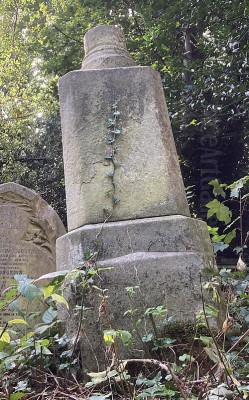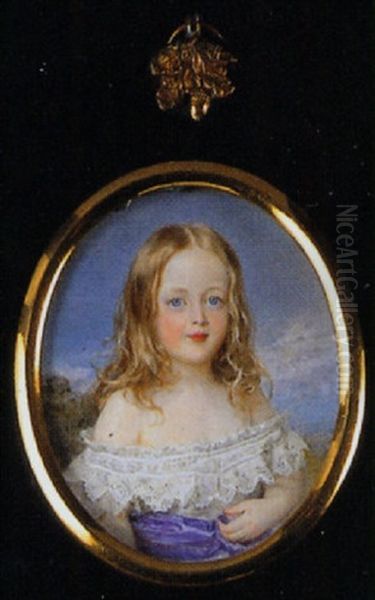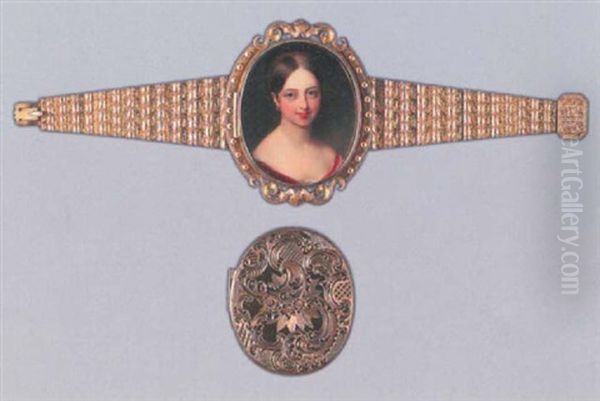
The 19th century was a period of profound transformation in the British art world, an era that witnessed the flourishing of Romanticism, the rise of the Pre-Raphaelites, and the enduring appeal of portraiture. Within this dynamic landscape, the delicate and intimate art of miniature painting held a special, albeit increasingly challenged, place. Among its most distinguished practitioners was Sir William Charles Ross, a prolific and highly sought-after artist whose career spanned the reigns of George IV, William IV, and much of Queen Victoria's early rule. His exceptional skill in capturing likeness and character on a small scale earned him royal patronage, academic honours, and a lasting reputation as one of the preeminent miniaturists of his time.
Early Life and Artistic Inclinations
William Charles Ross was born in London on June 3, 1794, into a family with artistic leanings. His father, William Ross, was a miniature painter and drawing master, providing young William with an early immersion in the world of art. His mother, Maria Smith, was also a portrait painter, further nurturing his nascent talents. This familial environment undoubtedly played a crucial role in shaping his artistic path. From a very young age, Ross demonstrated a remarkable aptitude for drawing and a keen eye for detail, qualities essential for success in the demanding field of miniature painting.
His precocious talent did not go unnoticed. In 1807, at the tender age of just thirteen, Ross received the "Lesser Silver Palette" from the Society of Arts for an ambitious historical drawing titled "The Death of Wat Tyler." This early accolade was a significant encouragement and a testament to his burgeoning abilities. The Society of Arts, now the Royal Society of Arts, played a vital role in promoting arts, manufactures, and commerce, and its awards were highly prestigious.
Academic Training and Early Career
Recognizing his potential, Ross was enrolled in the prestigious Royal Academy Schools in 1808. The Royal Academy, founded in 1768 with Sir Joshua Reynolds as its first president, was the paramount institution for artistic training and exhibition in Britain. Here, Ross would have studied from antique casts, life models, and the works of Old Masters, honing his draughtsmanship and understanding of composition.

His progress at the Academy was swift and marked by further successes. In 1809, he was awarded a silver medal for an original drawing, "The Judgement of Solomon," a complex biblical scene that would have tested his skills in figure composition and narrative expression. He received another silver medal from the Academy in 1810, possibly for "Venus and Cupid," further cementing his reputation as a student of exceptional promise. During this period, he also began to exhibit at the Royal Academy, with his first works appearing in its annual exhibition in 1809. This early exposure was crucial for an aspiring artist seeking to build a career.
A pivotal moment in his early professional development came in 1814 when he became an assistant to Andrew Robertson. Robertson (1777-1845) was a highly respected Scottish miniature painter who had established a successful practice in London. Working under Robertson provided Ross with invaluable practical experience and insight into the professional world of miniature painting, from client relations to the specific techniques required for working on ivory. Robertson himself was a significant figure, known for his robust and characterful miniatures, and his influence likely helped Ross refine his own approach.
Rise to Prominence and Royal Patronage
Throughout the 1810s and 1820s, Ross steadily built his reputation. He became known for the elegance of his style, the accuracy of his likenesses, and the delicate yet firm handling of his medium, typically watercolour on ivory. Miniature portraits were highly fashionable, serving as intimate keepsakes, tokens of affection, and portable records of family members and loved ones. They were often set into jewellery, such as lockets, brooches, or snuffbox lids.
Ross's talent did not escape the notice of the highest echelons of society. His skill in capturing not just a physical likeness but also a sense of the sitter's personality made him increasingly popular among the aristocracy and gentry. The true turning point in his career, however, was his introduction to royal circles. In 1836, he painted his first royal portrait, that of the young Princess Victoria, who would ascend to the throne the following year.
With Queen Victoria's accession in 1837, Ross's career reached new heights. The Queen herself was a keen admirer and collector of miniatures, and she quickly appointed Ross as her Miniature Painter in Ordinary. This prestigious appointment brought him a steady stream of commissions from the Queen, her consort Prince Albert (whom she married in 1840), their growing family, and numerous members of the extended royal household and visiting European royalty. He painted over fifty miniatures of Prince Albert and Princess Mary alone, indicative of the trust and favour he enjoyed.

His royal commissions included portraits of Queen Victoria herself, the Duchess of Kent (Victoria's mother), and many of their relatives and associates. These works were not only important records but also diplomatic gifts and personal mementos. The Queen's patronage solidified Ross's position as the leading miniaturist of his day. His services were sought by royalty from other European nations as well, including commissions from the courts of France, Belgium (King Leopold I and his family), Portugal, and Saxony.
Artistic Style and Technique
Sir William Charles Ross worked primarily in watercolour on ivory, the standard medium for miniature painting since the 18th century. Ivory provided a luminous, smooth surface that allowed for exquisite detail and subtle gradations of tone. Ross was a master of this demanding technique. His brushwork was incredibly fine, often employing stippling (tiny dots) and hatching (fine parallel lines) to build up form and colour.
His portraits are characterized by their refined elegance and psychological acuity. He possessed a remarkable ability to capture a sitter's likeness with great accuracy while also imbuing the portrait with a sense of their character and social standing. His compositions were often sophisticated, with attention paid to the sitter's attire, accessories, and sometimes a hint of background, though the focus invariably remained on the face. The backgrounds, while often simple, could be richly composed, adding depth and context to the portrait.
Ross's miniatures often display a delicate colour palette, with soft flesh tones and carefully rendered details of hair and fabric. He managed to achieve a sense of life and animation even on such a small scale. Unlike some earlier miniaturists like Richard Cosway, whose style could be more flamboyant, Ross's work tended towards a more naturalistic and dignified representation, fitting for the Victorian era's sensibilities. His style evolved over his long career, but he consistently maintained a high level of craftsmanship and artistic integrity.
The sheer volume of his output is astonishing: he is credited with painting over 2,200 miniatures during his lifetime. This productivity speaks not only to his diligence but also to the immense demand for his work. Approximately 300 of these were exhibited at the Royal Academy between 1809 and 1859, a testament to his consistent presence in the public eye.
Notable Works
Beyond his numerous royal portraits, several works stand out and are often cited as representative of his skill. While specific titles of all his "greatest hits" can be elusive due to the private nature of many miniature commissions, his body of work for the Royal Collection is particularly significant.
His portraits of Queen Victoria at various stages of her early reign are iconic, capturing her youth, dignity, and evolving role as a monarch and matriarch. Similarly, his miniatures of Prince Albert convey the intelligence and seriousness of the Prince Consort. The series of portraits of the royal children are charming and intimate, offering a glimpse into the private life of the royal family.
Other named works that appear in records include:
"The Honourable Sophia Cavendish"
"Sir Thomas Acland, 1st Baronet"
"Princess Margaret, daughter of the Duke of Nassau"
"The Pilgrim"
"Frederick Webb"
His early award-winning pieces, "The Death of Wat Tyler" and "The Judgement of Solomon," though likely larger drawings rather than miniatures, demonstrate his early ambition and skill in historical and biblical subjects, even if portraiture became his main focus.
Recognition and Honours
Ross's contributions to art were formally recognized by the Royal Academy. He was elected an Associate of the Royal Academy (ARA) in 1838, a significant step in an artist's career. This was followed by his election as a full Royal Academician (RA) in 1843, the highest honour the Academy could bestow, placing him among the elite of the British art establishment.
In 1842, Queen Victoria conferred a knighthood upon him, and he became Sir William Charles Ross. This was a clear mark of royal favour and public acknowledgement of his status as the preeminent miniature painter of the era. Such honours were not lightly given and underscored the esteem inwhich he was held.
The Wider Artistic Context and Contemporaries
Sir William Charles Ross practiced his art during a vibrant period in British art. While he specialized in miniatures, the broader art scene was dominated by painters working on a larger scale. Sir Thomas Lawrence (1769-1830) was the leading portrait painter in the grand manner during Ross's early career, and his style influenced a generation. After Lawrence's death, portraiture continued to thrive with artists like Sir Martin Archer Shee (who succeeded Lawrence as President of the Royal Academy) and later, Franz Xaver Winterhalter, a German painter who became a favourite of Queen Victoria for large-scale royal portraits.
In the realm of genre painting, Sir David Wilkie (1785-1841) was immensely popular for his scenes of everyday life. Historical painting was championed by artists such as Daniel Maclise (1806-1870) and Charles Lock Eastlake (1793-1865), who later became President of the Royal Academy and Director of the National Gallery. The landscape was being revolutionized by J.M.W. Turner (1775-1851) and John Constable (1776-1837), whose innovative approaches redefined the genre. Sir Edwin Landseer (1802-1873), another royal favourite, was renowned for his animal paintings.
Within the specific field of miniature painting, Ross had contemporaries, though few matched his level of success and royal patronage. Andrew Robertson, his former mentor, continued to practice. Other miniaturists of the period included figures like Alfred Edward Chalon (1780-1860), who was also a Painter in Watercolours to the Queen, and Robert Thorburn (1818-1885), who became a significant rival to Ross in later years and also enjoyed royal favour. The tradition of miniature painting had a rich history in Britain, with earlier masters like Nicholas Hilliard and Isaac Oliver in the Elizabethan and Jacobean eras, followed by Samuel Cooper in the 17th century, and Richard Cosway, George Engleheart, and John Smart in the late 18th and early 19th centuries, all of whom set high standards for the art form.
However, by the mid-19th century, the art of miniature painting faced a formidable new competitor: photography. The invention of the daguerreotype in 1839, followed by other photographic processes, offered a quicker and often cheaper way to obtain a likeness. While miniatures retained a certain prestige and artistic appeal, photography began to erode their traditional market. Ross's career flourished during the zenith of the miniature's popularity but also witnessed the beginnings of its decline as the dominant form of small-scale portraiture.
Personal Life and Later Years
Details about Sir William Charles Ross's personal life are somewhat scarce, as is often the case with artists whose public careers overshadow their private affairs. It is known that he never married. He dedicated his life to his art, and his immense output suggests a man of great diligence and focus.
His family background had a notable, if distant, historical connection. His great-grandfather, Walter Ross, was reportedly involved in the Covenanter uprisings in Scotland and is said to have died at the Battle of Bothwell Bridge in 1679, a significant event in Scottish religious and political history. While this was many generations removed, such family lore often forms part of an individual's identity.
In his later years, Ross suffered a stroke which led to paralysis. This debilitating illness effectively ended his painting career. He passed away at his home in Fitzroy Square, London, on January 20, 1860, at the age of 65. He had not fully recovered from the effects of the stroke. His death marked the end of an era for British miniature painting.
Legacy
Sir William Charles Ross is remembered as one of the last great masters of the art of miniature painting in Britain before its widespread decline due to the advent of photography. His career represents the pinnacle of the art form in the 19th century, characterized by technical brilliance, psychological insight, and immense popularity, particularly with the Royal Family.
His works are preserved in many prestigious collections, most notably the Royal Collection Trust, which holds a significant number of his royal portraits. Other museums and galleries, such as the Victoria and Albert Museum in London and the National Portrait Gallery, London, also house examples of his work. These miniatures serve as invaluable historical documents, providing intimate portraits of the leading figures of his time, as well as exquisite examples of a highly refined art form.
While the demand for painted miniatures waned significantly after his death, Ross's achievements set a standard against which later practitioners were measured. He successfully navigated the demands of elite patronage, maintained a consistently high artistic quality over a long and prolific career, and left behind a legacy of beautifully crafted portraits that continue to charm and impress viewers today. His life and work offer a fascinating window into the art world and society of Victorian England. He remains a key figure for anyone studying the history of British portraiture or the specialized art of the miniature.